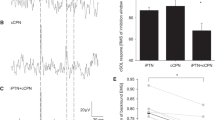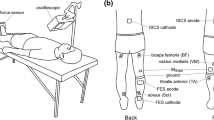Abstract
Purpose
This study aimed to determine whether the modulation of primary afferent depolarization (PAD) and homosynaptic post-activation depression (HPAD) are involved in the lower efficacy of Ia-afferent-α-motoneuron transmission commonly observed during lengthening compared to isometric and shortening conditions.
Methods
15 healthy young individuals participated in two experimental sessions dedicated to measurement in passive and active muscle states, respectively. In each session, PAD, HPAD and the efficacy of Ia-afferent-α-motoneuron transmission were evaluated during lengthening, shortening and isometric conditions. PAD was evaluated with D1 inhibition technique. Posterior tibial nerve stimulation was used to study HPAD and the efficacy of the Ia-afferent-α-motoneuron transmission through the recording of the soleus Hoffmann reflex (H reflex).
Results
PAD was increased in lengthening than shortening (11.2%) and isometric (12.3%) conditions regardless of muscle state (P < 0.001). HPAD was increased in lengthening than shortening (5.1%) and isometric (4.2%) conditions in the passive muscle state (P < 0.05), while no difference was observed in the active muscle state. H reflex was lower in lengthening than shortening (− 13.2%) and isometric (− 9.4%) conditions in both muscle states (P < 0.001).
Conclusion
These results highlight the specific regulation of PAD and HPAD during lengthening conditions. However, the differences observed during passive lengthening compared to shortening and isometric conditions seem to result from an increase in Ia-afferent discharge, while the variations highlighted during active lengthening might come from polysynaptic descending pathways involving supraspinal centres that could regulate PAD mechanism.






Similar content being viewed by others
Data availability statement
The datasets generated during and/or analysed during the current study are available from the corresponding author on reasonable request.
Abbreviations
- ANOVA:
-
Analysis of variance
- EMG:
-
Electromyography
- HPAD:
-
Homosynaptic post-activation depression
- H reflex:
-
Hoffmann reflex
- MVC:
-
Maximal voluntary contraction
- PSI:
-
Presynaptic inhibition
- PAD:
-
Primary afferent depolarization
- SOL:
-
Soleus
References
Aagaard P, Simonsen EB, Andersen JL et al (2000) Neural inhibition during maximal eccentric and concentric quadriceps contraction: effects of resistance training. J Appl Physiol 89:2249–2257. https://doi.org/10.1152/jappl.2000.89.6.2249
Abbruzzese G, Morena M, Spadavecchia L, Schieppati M (1994) Response of arm flexor muscles to magnetic and electrical brain stimulation during shortening and lengthening tasks in man. J Physiol 481(2):499–507. https://doi.org/10.1113/jphysiol.1994.sp020458
Achache V, Roche N, Lamy J-C et al (2010) Transmission within several spinal pathways in adults with cerebral palsy. Brain 133:1470–1483. https://doi.org/10.1093/brain/awq053
Amiridis IG, Martin A, Morlon B et al (1996) Co-activation and tension-regulating phenomena during isokinetic knee extension in sedentary and highly skilled humans. Eur J Appl Physiol Occup Physiol 73:149–156. https://doi.org/10.1007/BF00262824
Aymard C, Katz R, Lafitte C et al (2000) Presynaptic inhibition and homosynaptic depression: a comparison between lower and upper limbs in normal human subjects and patients with hemiplegia. Brain 123(8):1688–1702. https://doi.org/10.1093/brain/123.8.1688
Babault N, Pousson M, Michaut A, Van Hoecke J (2003) Effect of quadriceps femoris muscle length on neural activation during isometric and concentric contractions. J Appl Physiol 94:983–990. https://doi.org/10.1152/japplphysiol.00717.2002
Barrué-Belou S, Marque P, Duclay J (2019) Supraspinal control of recurrent inhibition during anisometric contractions. Med Sci Sports Exerc 51:2357–2365. https://doi.org/10.1249/MSS.0000000000002042
Barrué-Belou S, Marque P, Duclay J (2018) Recurrent inhibition is higher in eccentric compared to isometric and concentric maximal voluntary contractions. Acta Physiol 223:e13064
Baudry S, Duchateau J (2012) Age-related influence of vision and proprioception on Ia presynaptic inhibition in soleus muscle during upright stance. J Physiol 590:5541–5554. https://doi.org/10.1113/jphysiol.2012.228932
Baudry S, Maerz AH, Gould JR, Enoka RM (2011) Task- and time-dependent modulation of Ia presynaptic inhibition during fatiguing contractions performed by humans. J Neurophysiol 106:265–273. https://doi.org/10.1152/jn.00954.2010
Budini F, Tilp M (2016) Changes in H-reflex amplitude to muscle stretch and lengthening in humans. Rev Neurosci 27:511–522. https://doi.org/10.1515/revneuro-2016-0001
Burke D (1980) Muscle spindle function during movement. Trends Neurosci 3:251–253. https://doi.org/10.1016/0166-2236(80)90093-4
Burke D, Hagbarth KE, Löfstedt L (1978) Muscle spindle activity in man during shortening and lengthening contractions. J Physiol 277:131–142. https://doi.org/10.1113/jphysiol.1978.sp012265
Cattagni T, Merlet AN, Cornu C, Jubeau M (2018) H-reflex and M-wave recordings: effect of pressure application to the stimulation electrode on the assessment of evoked potentials and subject’s discomfort. Clin Physiol Funct Imag 38:416–424. https://doi.org/10.1111/cpf.12431
Chen B, Perez MA (2022) Altered regulation of Ia afferent input during voluntary contraction in humans with spinal cord injury. Elife 11:e80089
Crone C, Nielsen J (1989) Methodological implications of the post activation depression of the soleus H-reflex in man. Exp Brain Res 78:28–32. https://doi.org/10.1007/BF00230683
Desmedt JE, Godaux E (1978) Mechanism of the vibration paradox: excitatory and inhibitory effects of tendon vibration on single soleus muscle motor units in man. J Physiol 285:197–207. https://doi.org/10.1113/jphysiol.1978.sp012567
Doguet V, Nosaka K, Guével A et al (2017) Muscle length effect on corticospinal excitability during maximal concentric, isometric and eccentric contractions of the knee extensors. Exp Physiol 102:1513–1523. https://doi.org/10.1113/EP086480
Duchateau J, Enoka RM (2008) Neural control of shortening and lengthening contractions: influence of task constraints. J Physiol 586:5853–5864. https://doi.org/10.1113/jphysiol.2008.160747
Duclay J, Martin A (2005) Evoked H-reflex and V-wave responses during maximal isometric, concentric, and eccentric muscle contraction. J Neurophysiol 94:3555–3562. https://doi.org/10.1152/jn.00348.2005
Duclay J, Pasquet B, Martin A, Duchateau J (2014) Specific modulation of spinal and cortical excitabilities during lengthening and shortening submaximal and maximal contractions in plantar flexor muscles. J Appl Physiol 117:1440–1450. https://doi.org/10.1152/japplphysiol.00489.2014
Duclay J, Pasquet B, Martin A, Duchateau J (2011) Specific modulation of corticospinal and spinal excitabilities during maximal voluntary isometric, shortening and lengthening contractions in synergist muscles. J Physiol 589:2901–2916. https://doi.org/10.1113/jphysiol.2011.207472
Fumoto M, Komiyama T, Nishihira Y (2002) Soleus H-reflex dynamics during fast plantarflexion in humans. J Electromyogr Kinesiol 12:367–374. https://doi.org/10.1016/s1050-6411(02)00030-5
Grosprêtre S, Papaxanthis C, Martin A (2014) Modulation of spinal excitability by a sub-threshold stimulation of M1 area during muscle lengthening. Neuroscience 263:60–71. https://doi.org/10.1016/j.neuroscience.2014.01.013
Guilhem G, Doguet V, Hauraix H et al (2016) Muscle force loss and soreness subsequent to maximal eccentric contractions depend on the amount of fascicle strain in vivo. Acta Physiol 217:152–163. https://doi.org/10.1111/apha.12654
Hopkins JT, Ingersoll CD, Cordova ML, Edwards JE (2000) Intrasession and intersession reliability of the soleus H-reflex in supine and standing positions. Electromyogr Clin Neurophysiol 40:89–94
Hulliger M, Nordh E, Vallbo AB (1985) Discharge in muscle spindle afferents related to direction of slow precision movements in man. J Physiol 362:437–453. https://doi.org/10.1113/jphysiol.1985.sp015687
Hultborn H, Meunier S, Pierrot-Deseilligny E, Shindo M (1987) Changes in presynaptic inhibition of Ia fibres at the onset of voluntary contraction in man. J Physiol 389:757–772. https://doi.org/10.1113/jphysiol.1987.sp016681
Hultborn H, Illert M, Nielsen J et al (1996) On the mechanism of the post-activation depression of the H-reflex in human subjects. Exp Brain Res 108:450–462. https://doi.org/10.1007/BF00227268
Katz R, Meunier S, Pierrot-Deseilligny E (1988) Changes in presynaptic inhibition of Ia fibres in man while standing. Brain 111(2):417–437. https://doi.org/10.1093/brain/111.2.417
Komi PV, Linnamo V, Silventoinen P, Sillanpää M (2000) Force and EMG power spectrum during eccentric and concentric actions. Med Sci Sports Exerc 32:1757–1762. https://doi.org/10.1097/00005768-200010000-00015
Lamy J-C, Wargon I, Mazevet D et al (2009) Impaired efficacy of spinal presynaptic mechanisms in spastic stroke patients. Brain 132:734–748. https://doi.org/10.1093/brain/awn310
Linnamo V, Moritani T, Nicol C, Komi PV (2003) Motor unit activation patterns during isometric, concentric and eccentric actions at different force levels. J Electromyogr Kinesiol 13:93–101. https://doi.org/10.1016/s1050-6411(02)00063-9
Magalhães FH, Elias LA, da Silva CR et al (2015) D1 and D2 Inhibitions of the Soleus H-Reflex Are Differentially Modulated during Plantarflexion Force and Position Tasks. PLoS ONE 10:e0143862
Matthews PBC (2011) Muscle Spindles: Their Messages and Their Fusimotor Supply. In: Comprehensive Physiology. John Wiley Sons
Meunier S, Pierrot-Deseilligny E (1998) Cortical control of presynaptic inhibition of Ia afferents in humans. Exp Brain Res 119:415–426. https://doi.org/10.1007/s002210050357
Mizuno Y, Tanaka R, Yanagisawa N (1971) Reciprocal group I inhibition on triceps surae motoneurons in man. J Neurophysiol 34:1010–1017. https://doi.org/10.1152/jn.1971.34.6.1010
Nielsen J, Petersen N (1994) Is presynaptic inhibition distributed to corticospinal fibres in man? J Physiol 477:47–58. https://doi.org/10.1113/jphysiol.1994.sp020170
Nielsen J, Pierrot-Deseilligny E (1996) Evidence of facilitation of soleus-coupled Renshaw cells during voluntary co-contraction of antagonistic ankle muscles in man. J Physiol 493(Pt 2):603–611. https://doi.org/10.1113/jphysiol.1996.sp021407
Nordlund MM, Thorstensson A, Cresswell AG (2002) Variations in the soleus H-reflex as a function of activation during controlled lengthening and shortening actions. Brain Res 952:301–307. https://doi.org/10.1016/s0006-8993(02)03259-6
Nordlund MM, Thorstensson A, Cresswell AG (2004) Conditioning Ia-afferent stimulation reduces the soleus Hoffman reflex in humans when muscle spindles are assumed to be inactive. Neurosci Lett 366:250–253. https://doi.org/10.1016/j.neulet.2004.05.044
Pasquet B, Carpentier A, Duchateau J, Hainaut K (2000) Muscle fatigue during concentric and eccentric contractions. Muscle Nerve 23:1727–1735. https://doi.org/10.1002/1097-4598(200011)23:11%3c1727::aid-mus9%3e3.0.co;2-y
Petersen NT, Butler JE, Carpenter MG, Cresswell AG (2007) Ia-afferent input to motoneurons during shortening and lengthening muscle contractions in humans. J Appl Physiol 102:144–148. https://doi.org/10.1152/japplphysiol.00362.2006
Pierrot-Deseilligny E, Burke D (2005) The Circuitry of the Human Spinal Cord: Its Role in Motor Control and Movement Disorders. Cambridge University Press, Newyork
Pierrot-Deseilligny E, Mazevet D (2000) The monosynaptic reflex: a tool to investigate motor control in humans. Interest Limits Neurophysiol Clin 30:67–80. https://doi.org/10.1016/s0987-7053(00)00062-9
Pinniger GJ, Nordlund M, Steele JR, Cresswell AG (2001) H-reflex modulation during passive lengthening and shortening of the human triceps surae. J Physiol 534:913–923. https://doi.org/10.1111/j.1469-7793.2001.00913.x
Proske U, Morgan DL, Gregory JE (1993) Thixotropy in skeletal muscle and in muscle spindles: a review. Prog Neurobiol 41:705–721. https://doi.org/10.1016/0301-0082(93)90032-n
Racinais S, Cresswell AG (2013) Temperature affects maximum H-reflex amplitude but not homosynaptic postactivation depression. Physiol Rep. https://doi.org/10.1002/phy2.19
Romanò C, Schieppati M (1987) Reflex excitability of human soleus motoneurones during voluntary shortening or lengthening contractions. J Physiol 390:271–284. https://doi.org/10.1113/jphysiol.1987.sp016699
Rudomin P, Schmidt RF (1999) Presynaptic inhibition in the vertebrate spinal cord revisited. Exp Brain Res 129:1–37. https://doi.org/10.1007/s002210050933
Schieppati M (1987) The Hoffmann reflex: a means of assessing spinal reflex excitability and its descending control in man. Prog Neurobiol 28:345–376. https://doi.org/10.1016/0301-0082(87)90007-4
Souron R, Baudry S, Millet GY, Lapole T (2019) Vibration-induced depression in spinal loop excitability revisited. J Physiol 597:5179–5193. https://doi.org/10.1113/JP278469
Tucker KJ, Tuncer M, Türker KS (2005) A review of the H-reflex and M-wave in the human triceps surae. Hum Mov Sci 24:667–688. https://doi.org/10.1016/j.humov.2005.09.010
Westing SH, Cresswell AG, Thorstensson A (1991) Muscle activation during maximal voluntary eccentric and concentric knee extension. Eur J Appl Physiol Occup Physiol 62:104–108. https://doi.org/10.1007/BF00626764
Author information
Authors and Affiliations
Contributions
All authors conceived and designed research. JC conducted the experiments and collected the data. JC analyzed the data. JC, JD, TC and MJ drafted the manuscript. All authors provided critical appraisal to the manuscript and approved the final version.
Corresponding author
Ethics declarations
Conflict of interest
The authors have no relevant financial or non-financial interests to disclose.
Additional information
Communicated by Michael I Lindinger.
Publisher's Note
Springer Nature remains neutral with regard to jurisdictional claims in published maps and institutional affiliations.
Rights and permissions
Springer Nature or its licensor (e.g. a society or other partner) holds exclusive rights to this article under a publishing agreement with the author(s) or other rightsholder(s); author self-archiving of the accepted manuscript version of this article is solely governed by the terms of such publishing agreement and applicable law.
About this article
Cite this article
Colard, J., Jubeau, M., Duclay, J. et al. Regulation of primary afferent depolarization and homosynaptic post-activation depression during passive and active lengthening, shortening and isometric conditions. Eur J Appl Physiol 123, 1257–1269 (2023). https://doi.org/10.1007/s00421-023-05147-x
Received:
Accepted:
Published:
Issue Date:
DOI: https://doi.org/10.1007/s00421-023-05147-x




